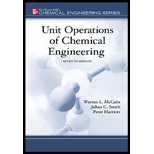
Concept explainers
(a)
Interpretation:
The steam consumption, evaporator economy, and surface area are to be determined when the temperature of the feed is
Concept Introduction :
First and foremost, the mass flow rate of vapor and product stream coming out of the evaporator are to be determined. Then based on temperature-pressure conditions, enthalpy of vaporization of liquid and steam is needed. Then, steam consumption can be determined as the product of vapor flow rate and enthalpy ratio of vaporization enthalpy over steam enthalpy (based on steam temperature). On the other hand, evaporator economy, and surface area requirements depend on the feed temperature and overall material and enthalpy balance calculations.
(a)
Answer to Problem 16.1P
The steam consumption rate is
Explanation of Solution
Given,
Feed flow rate
Solid fraction in feed
Solid fraction in the product
Solid fraction in vapor
Feed temperature
Steam temperature
Specific heat capacity of feed
Overall heat transfer coefficient
An overall material balance on the evaporator is given by the following expression.
Here,
Overall solid balance on the evaporator is given by the following expression.
Putting values of known variables gives the following.
Using the value of product flow rate in equation (1) gives the following.
Given the pressure inside the evaporator is
Using a steam table shows that at this pressure the corresponding saturation temperature using the steam table is approximately
Boiling point rise (BPR) is neglected. Assume that the vaporized stream exhibits the same properties as water.
Using the temperature of
Given steam temperature is
Overall enthalpy balance on the evaporator is given by the following expression.
Here,
In order to compute the steam consumption, no enthalpy contribution by feed and product stream is taken into consideration.
Then the above equation changes in the following manner.
Using equation (2) as the basis for further calculations, the following is obtained.
The steam economy
The heat transfer area
(b)
Interpretation:
The steam consumption, evaporator economy, and surface area are to be determined when the temperature of the feed is
Concept Introduction :
First and foremost, the mass flow rate of vapor and product stream coming out of the evaporator are to be determined. Then based on temperature-pressure conditions, enthalpy of vaporization of liquid and steam is needed. Then, steam consumption can be determined as the product of vapor flow rate and enthalpy ratio of vaporization enthalpy over steam enthalpy (based on steam temperature). On the other hand, evaporator economy, and surface area requirements depend on the feed temperature and overall material and enthalpy balance calculations.
(b)
Answer to Problem 16.1P
The steam consumption rate is
Explanation of Solution
Before proceeding, consider the following.
Reference feed temperature
New feed temperature
Net heat
Net heat in the vapor stream
The total heat
Therefore, steam consumption is obtained as below.
The steam economy
The heat transfer area
(c)
Interpretation:
The steam consumption, evaporator economy, and surface area are to be determined when the temperature of the feed is
Concept Introduction :
First and foremost, the mass flow rate of vapor and product stream coming out of the evaporator are to be determined. Then based on temperature-pressure conditions, enthalpy of vaporization of liquid and steam is needed. Then, steam consumption can be determined as the product of vapor flow rate and enthalpy ratio of vaporization enthalpy over steam enthalpy (based on steam temperature). On the other hand, evaporator economy, and surface area requirements depend on the feed temperature and overall material and enthalpy balance calculations.
(c)
Answer to Problem 16.1P
The steam consumption rate is
Explanation of Solution
Before proceeding, consider the following.
Reference feed temperature
New feed temperature
Net heat
Net heat in the vapor stream
The total heat
Therefore, steam consumption is obtained as below.
The steam economy
The heat transfer area
Want to see more full solutions like this?
Chapter 16 Solutions
Unit Operations of Chemical Engineering
 Introduction to Chemical Engineering Thermodynami...Chemical EngineeringISBN:9781259696527Author:J.M. Smith Termodinamica en ingenieria quimica, Hendrick C Van Ness, Michael Abbott, Mark SwihartPublisher:McGraw-Hill Education
Introduction to Chemical Engineering Thermodynami...Chemical EngineeringISBN:9781259696527Author:J.M. Smith Termodinamica en ingenieria quimica, Hendrick C Van Ness, Michael Abbott, Mark SwihartPublisher:McGraw-Hill Education Elementary Principles of Chemical Processes, Bind...Chemical EngineeringISBN:9781118431221Author:Richard M. Felder, Ronald W. Rousseau, Lisa G. BullardPublisher:WILEY
Elementary Principles of Chemical Processes, Bind...Chemical EngineeringISBN:9781118431221Author:Richard M. Felder, Ronald W. Rousseau, Lisa G. BullardPublisher:WILEY Elements of Chemical Reaction Engineering (5th Ed...Chemical EngineeringISBN:9780133887518Author:H. Scott FoglerPublisher:Prentice Hall
Elements of Chemical Reaction Engineering (5th Ed...Chemical EngineeringISBN:9780133887518Author:H. Scott FoglerPublisher:Prentice Hall
 Industrial Plastics: Theory and ApplicationsChemical EngineeringISBN:9781285061238Author:Lokensgard, ErikPublisher:Delmar Cengage Learning
Industrial Plastics: Theory and ApplicationsChemical EngineeringISBN:9781285061238Author:Lokensgard, ErikPublisher:Delmar Cengage Learning Unit Operations of Chemical EngineeringChemical EngineeringISBN:9780072848236Author:Warren McCabe, Julian C. Smith, Peter HarriottPublisher:McGraw-Hill Companies, The
Unit Operations of Chemical EngineeringChemical EngineeringISBN:9780072848236Author:Warren McCabe, Julian C. Smith, Peter HarriottPublisher:McGraw-Hill Companies, The





